ASUS Transformer Book T100 Review: Redefining the Entry-Level Windows Notebook
by Anand Lal Shimpi on October 18, 2013 12:00 AM ESTCPU Performance
The Atom Z3740 in the T100 features a 9% lower base clock and 22.5% lower max turbo frequency than the Z3770 we previewed back at IDF. Given how good of a job Bay Trail does turboing up to max frequencies under normal use, I’d expect proportionally lower scores in our tests.
I’ll start with our cross platform browser based benchmarks before moving on to a look at the Z3740 vs. Z3770.
Note for all of these benchmarks I’ve used Google’s Chrome browser. IE11 integrates well into the modern UI of Windows 8.1 but is otherwise a pretty terrible browser by comparison. I think the modern UI Chrome experience on 8.1 isn’t as good, but it’s a better/faster/less-finicky option. Out of all of our tests only SunSpider seems to run quicker under IE11, whereas Chrome wins everywhere else. I think it’s a bit insane to switch between browsers based on the benchmark being run, so we’re sticking with Chrome across the board.
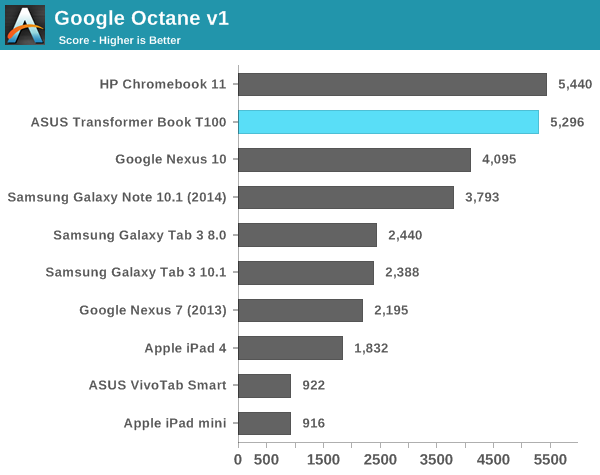
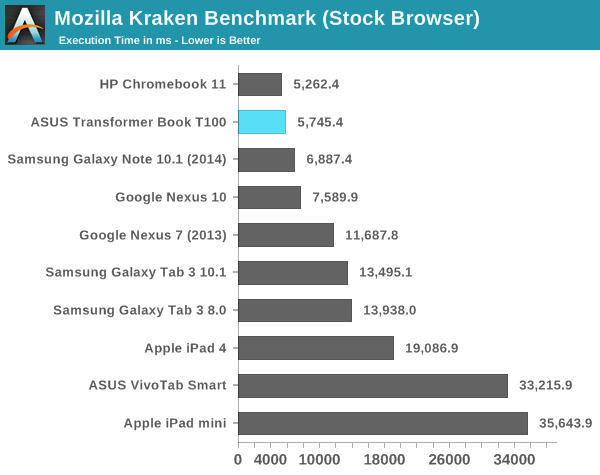
Lightly threaded performance is actually quite comparable to the Chromebook 11, which was a bit surprising. Throw a multitasking workload at the two notebooks and you'll separate the boys from the men though:
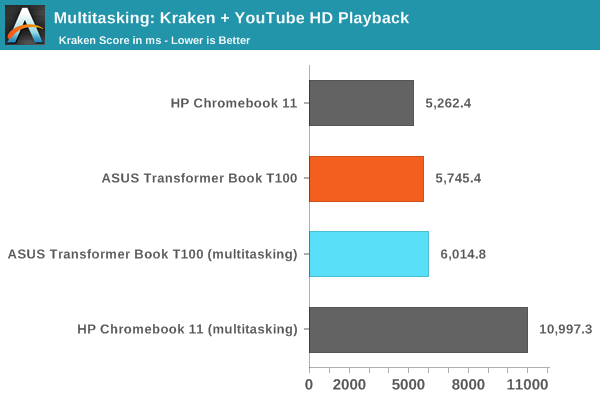
Chrome under Chrome OS performs extremely well for obvious reasons. But here the T100's additional cores and solid memory interface really come in handy when multitasking, there's hardly any performance penalty for this sort of multitasking on Bay Trail while the dual-core Cortex A15 based Chromebook needs serious help.

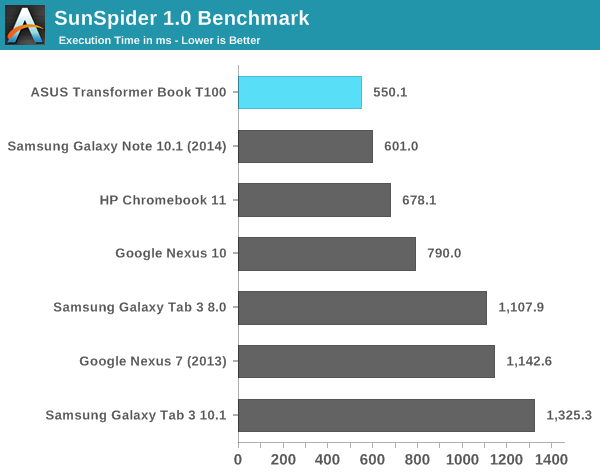
The T100 remains extremely competitive compared to the Chromebook 11 and definitely compared to Android tablets.
Next up is putting the Atom Z3740's performance in perspective compared to our earlier FFRD data:

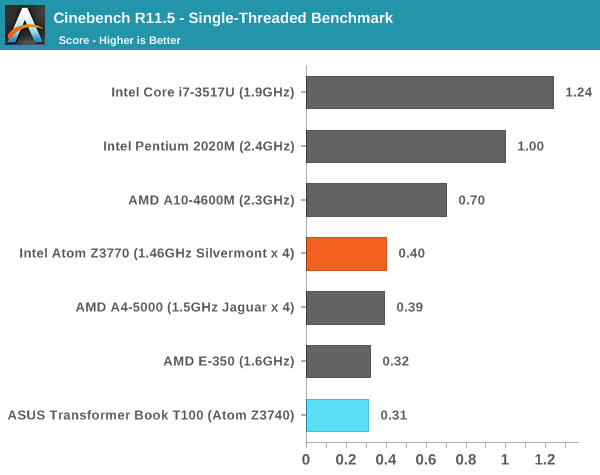


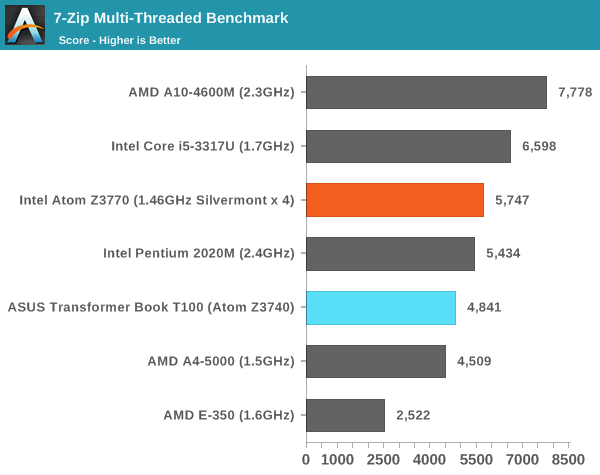
In all of these tests we see nearly perfect scaling compared to the Atom Z3770. Turbo frequencies are regularly hit when under load, and as a result see see proportionally lower performance from the T100. I would’ve liked to have seen the Z3770 used in the T100, but not if it meant a higher price, an optional dock or a worse display.
GPU Performance
I didn’t have a ton of time to go through gaming performance on the T100, but with a quarter of the EUs of Ivy Bridge it’s clear that you shouldn’t expect a GPU monster out of Bay Trail. In our cross platform graphics tests however the T100 is quite competitive, although not industry leading by any means.
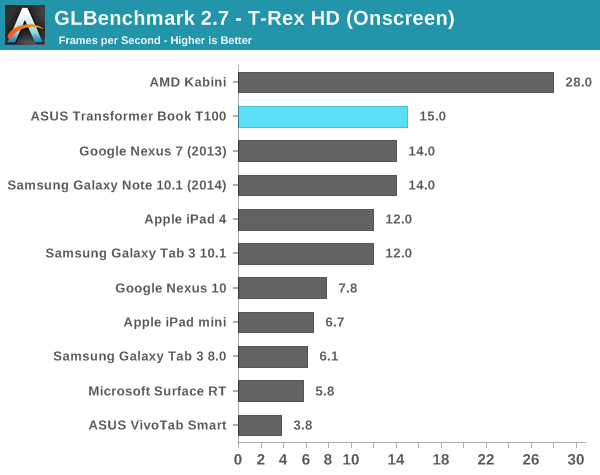
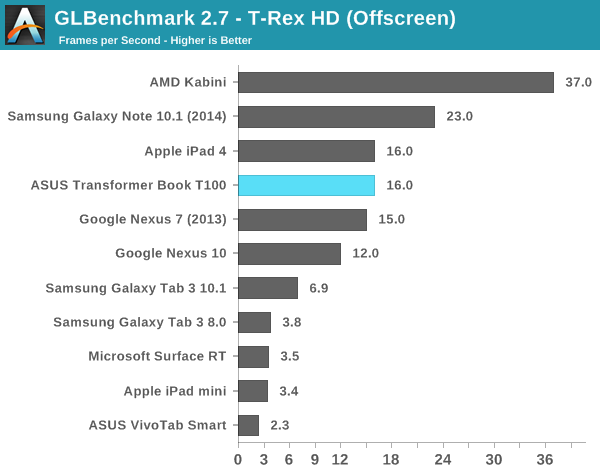
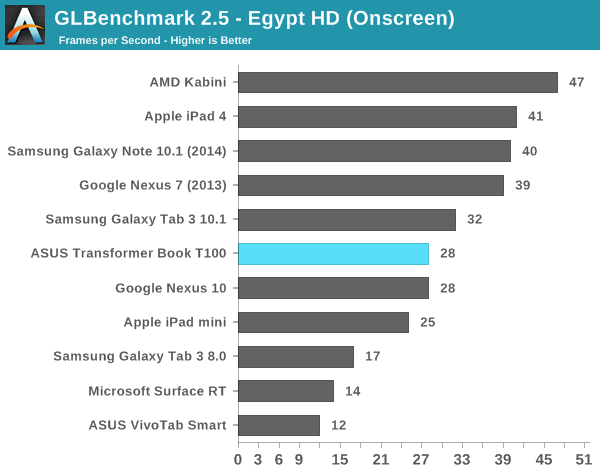
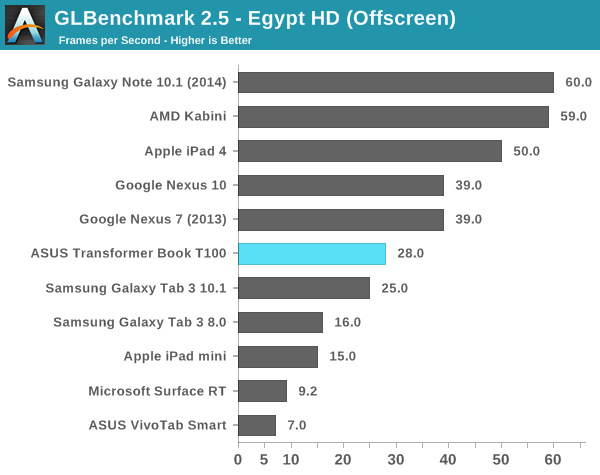
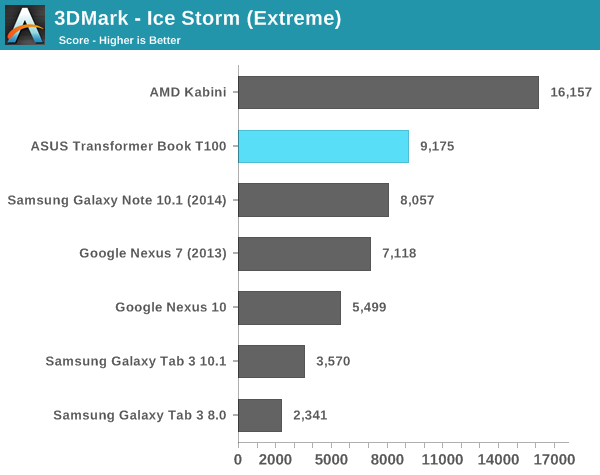

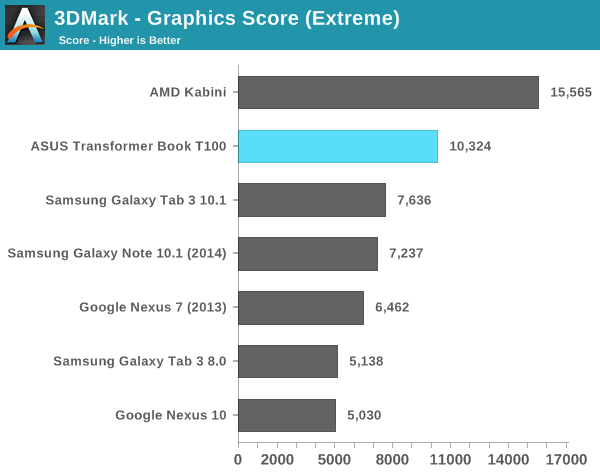
I did see some choppy animations at times and indications that the GPU (or its drivers) weren’t up to snuff, but that’s exclusively in classic desktop mode. In the modern UI, the Atom Z3740 was very smooth.
Storage Performance
Our Android IO tests rely on Androbench with a relatively limited LBA span. I increased the difficulty of the test a bit under Windows 8.1 but still kept it reasonable since we are dealing with eMMC solutions. I’m testing across a 1GB LBA span and testing for a period of 1 minute, which is an ok balance between difficulty of workload and sensitivity to the fact that we’re evaluating low-class SSDs here.
Sequential read and write performance is competitive with the high-end examples we’ve seen in the Android space. Random read performance is similarly good, while random write performance is appreciably better than what we’re used to in Android tablets. It is good to see ASUS/Intel/Microsoft concerned about random write performance, but I’d still like to see a 5 - 10x increase in these numbers with a focus on sustained performance before I’m truly happy.
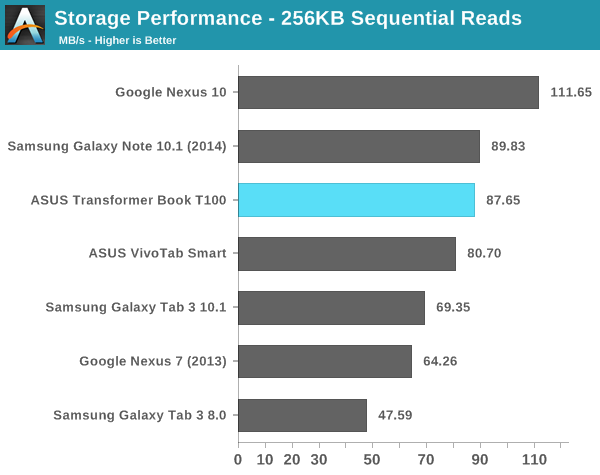
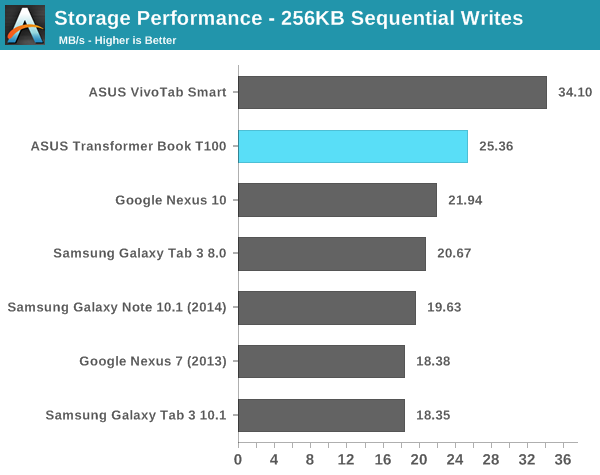
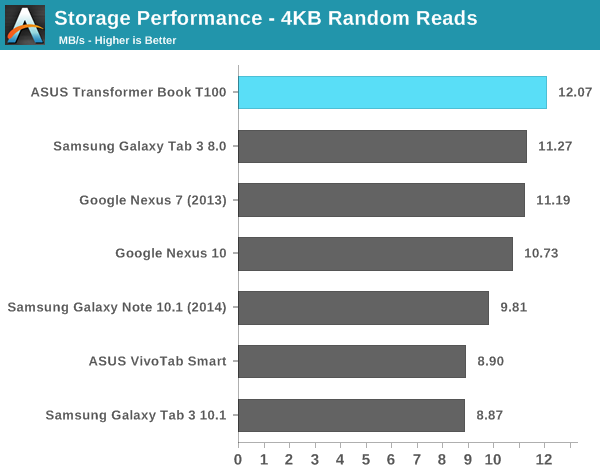
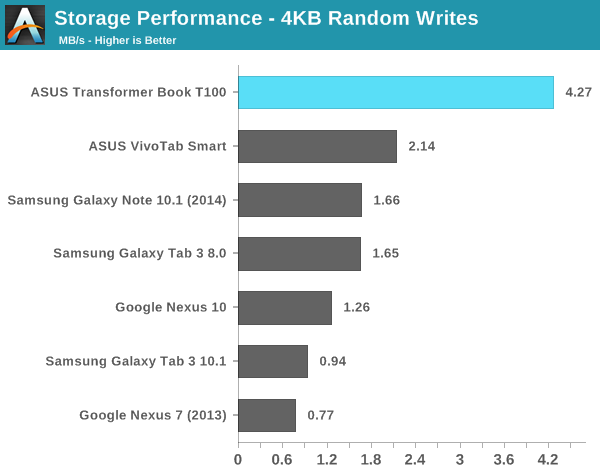










158 Comments
View All Comments
Nagorak - Friday, October 18, 2013 - link
They both include the dock. I wish they would sell a cheaper version without the keyboard, at least as an option.AsusJake - Sunday, October 16, 2016 - link
that's the thing and I know I'm like 3 years ahead of this article, the asus t100 is not a TABLET. its a 2in1 hybrid. its a compact laptop with a removable touch screen. the other devices are just bs tabletsDrunktroop - Friday, October 18, 2013 - link
Battery Life seems acceptable, at least it stayed more or less the same as Clover Trail and being quicker at the same time.However, 2GB RAM is quite concerning here, I personally use a ThinkPad Tablet 2 at school,
which can use 1.8GB RAM with just OneNote & IE & some PDF documents.
Using Bay Trail as 32-bit SoC with 2GB RAM & Windows is not a good idea IMO,
it is not that sufficient by today standard.
ricardodawkins - Friday, October 18, 2013 - link
then buy something with 4GB of RAM or that can be upgraded. This is a 350.00 tablet.popej - Friday, October 18, 2013 - link
I agree, 2GB for Windows hardware is substandard. My 3 years old netbook supports 2GB.AsusJake - Sunday, October 16, 2016 - link
3 years later I'm still using an asus t100 now with windows 10 64 bit.... has ran and continues to 3 years after this article . ive trashed atleast 6 tabletsKhato - Friday, October 18, 2013 - link
Out of curiosity, does the Intel Power Gadget - http://software.intel.com/en-us/articles/intel-pow... - work with Baytrail? Would be quite interesting to see what it reports for package power under the various workloads if it does.Penti - Friday, October 18, 2013 - link
This is a good example why Intel's approach of really low-end devices succeeds and why Microsoft's Windows RT attempts fail. Intel gets ~30 USD, Microsoft still gets a fair share of licensing money but the user gets a full 2013 Home edition suite including damn macro/vba-support that RT doesn't provide. It supports connected standby (Surface 2 don't), but I would wait till these devices run 64-bit Windows. It does show that when they run the exact same platform and Metro is basically just the start screen that is still powered by Win32 underneath it does make RT entirely pointless. It has still better battery life than first gen RT-devices. Dock is obviously an necessity for all the Win32 apps this thing is suppose to runjhoff80 - Friday, October 18, 2013 - link
" It supports connected standby (Surface 2 don't)"Surface Pro 2 doesn't. Surface 2 (and the Surface RT, for that matter) will of course support Connected Standby.
As for macro and VBA support, it might be useful to you, but how common is that stuff in general? Seems pretty rare these days to me.
Krysto - Friday, October 18, 2013 - link
Could do without the sensationalist title.